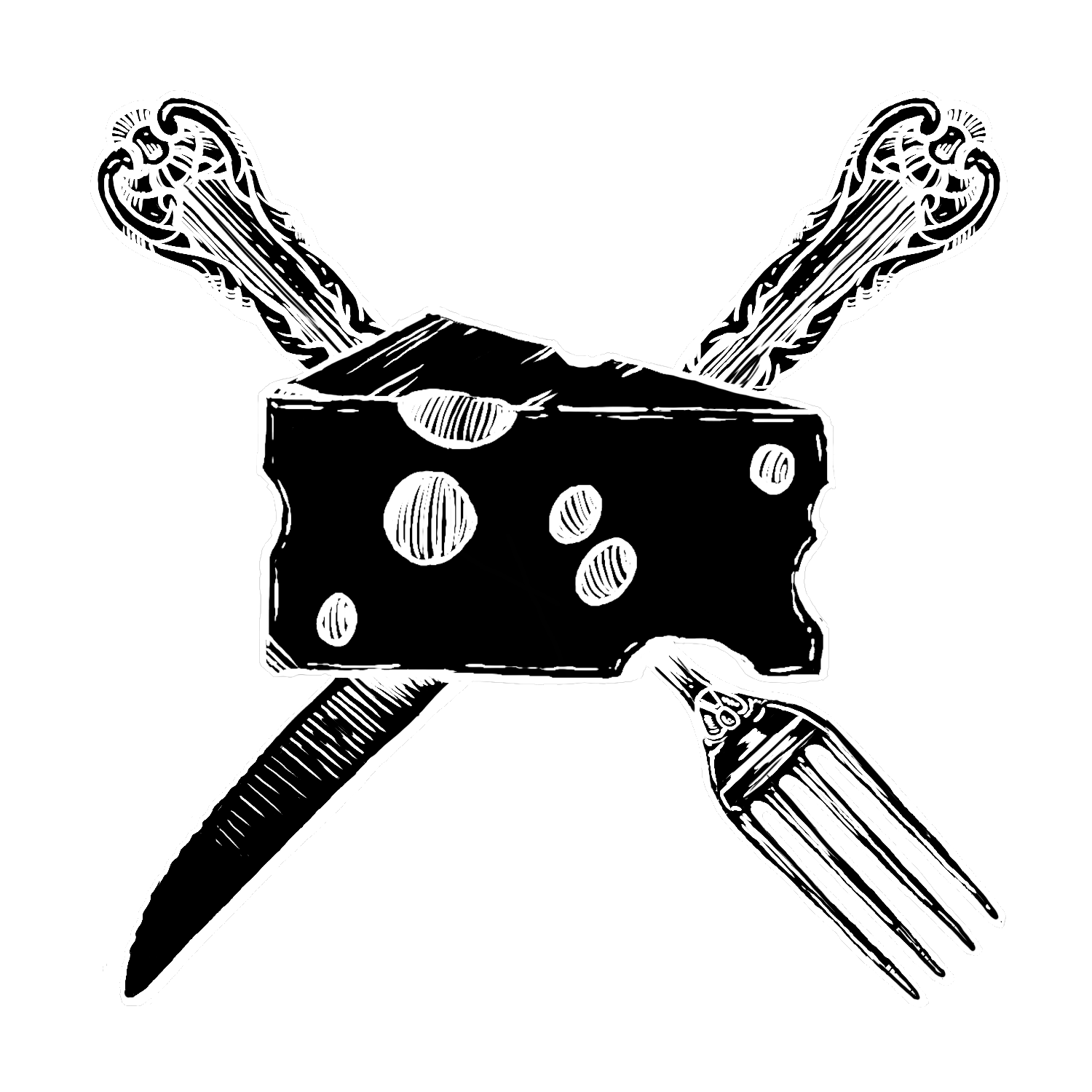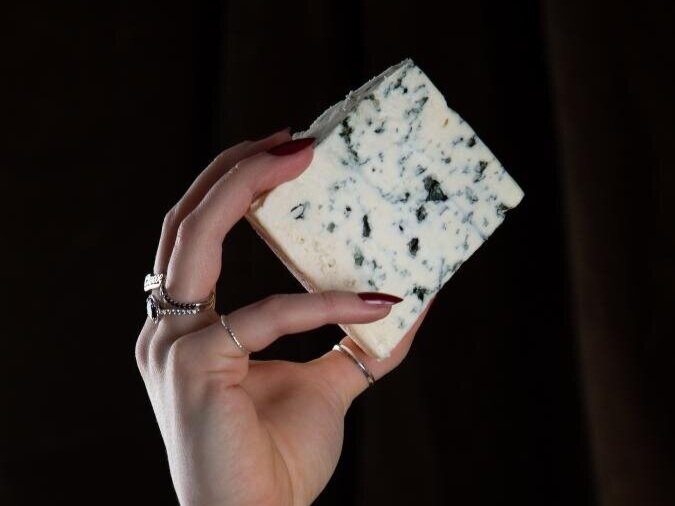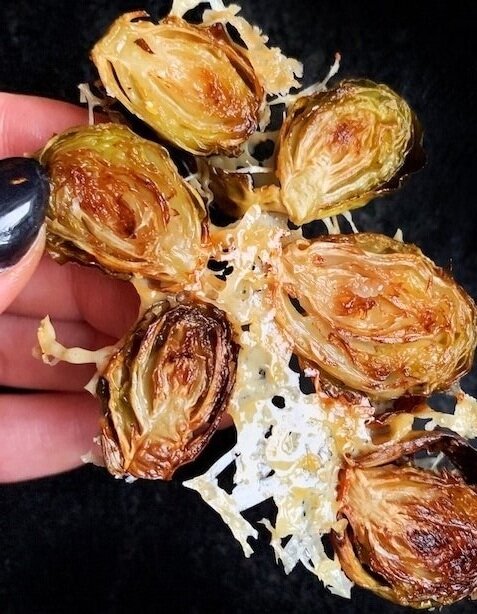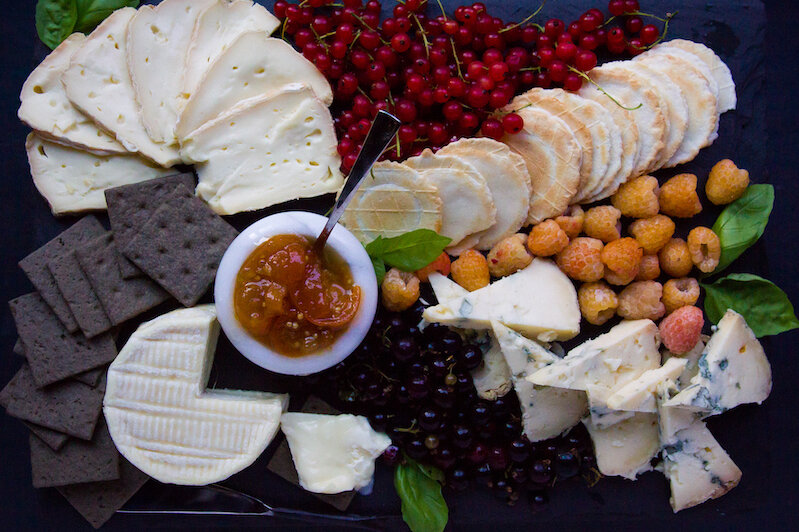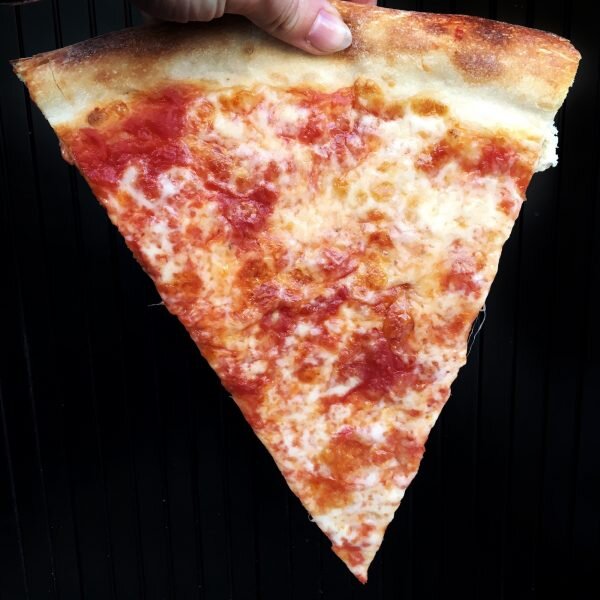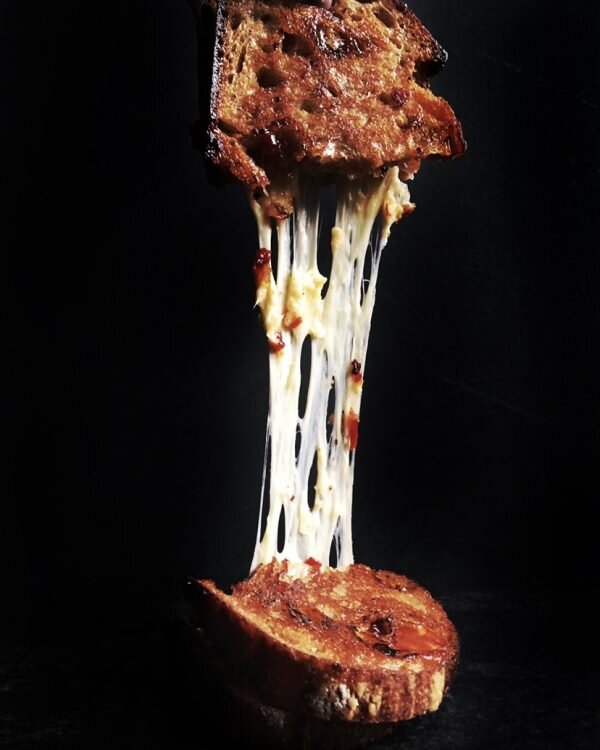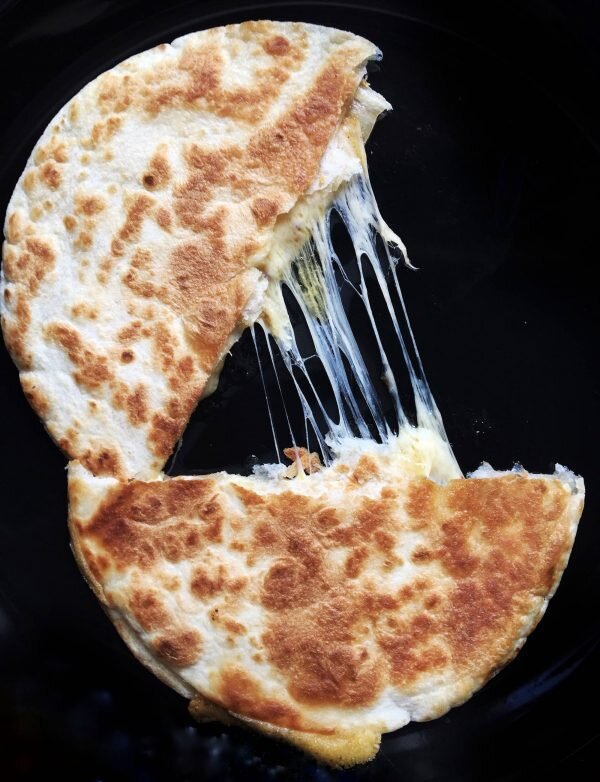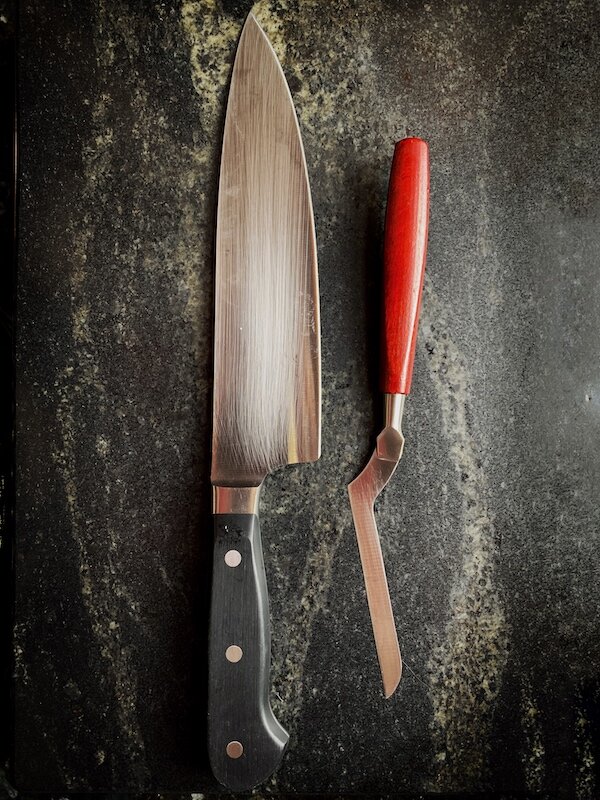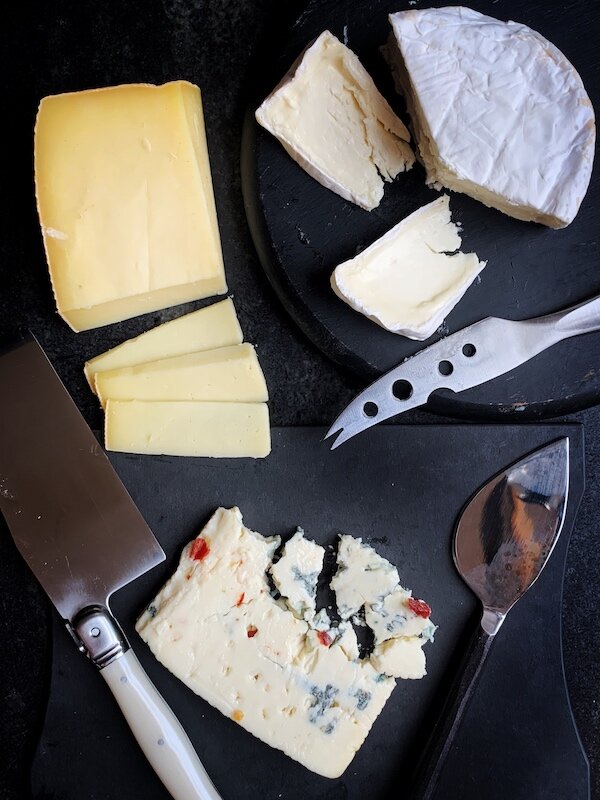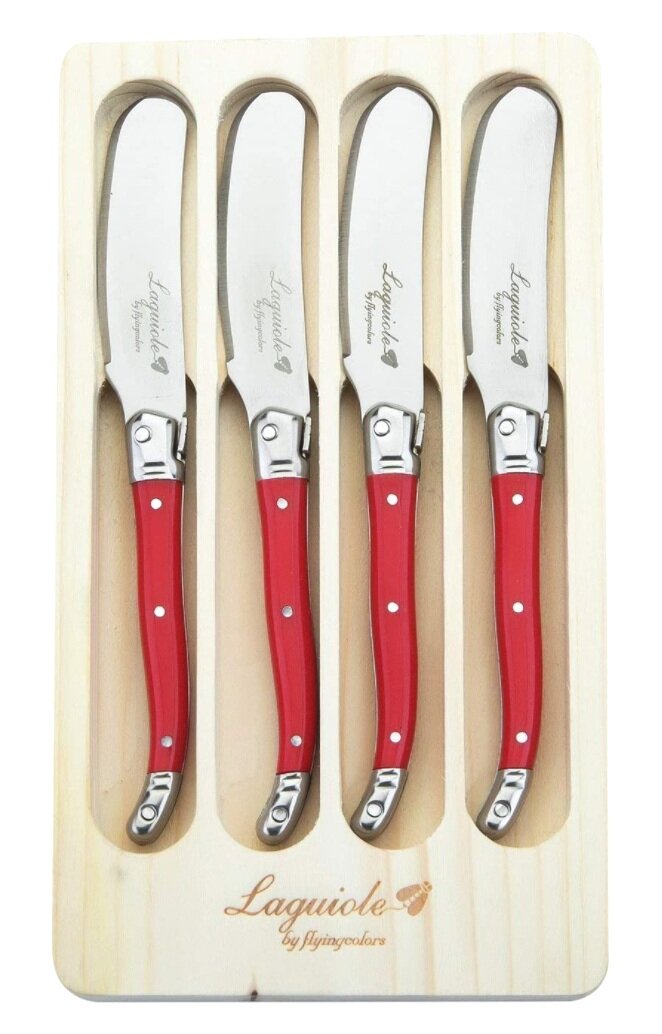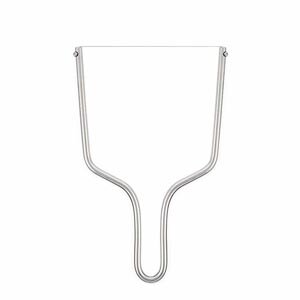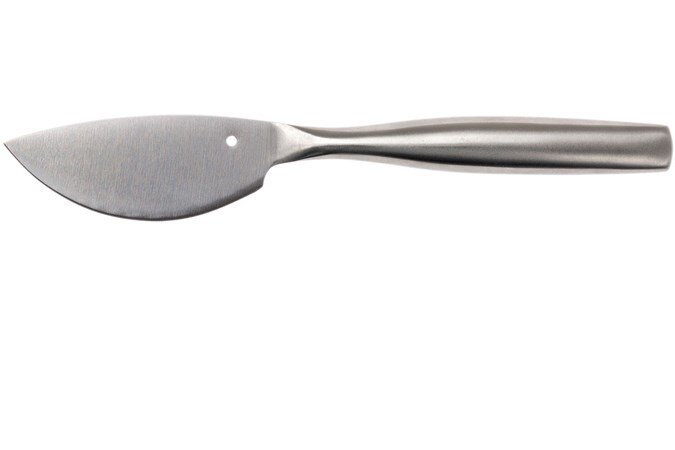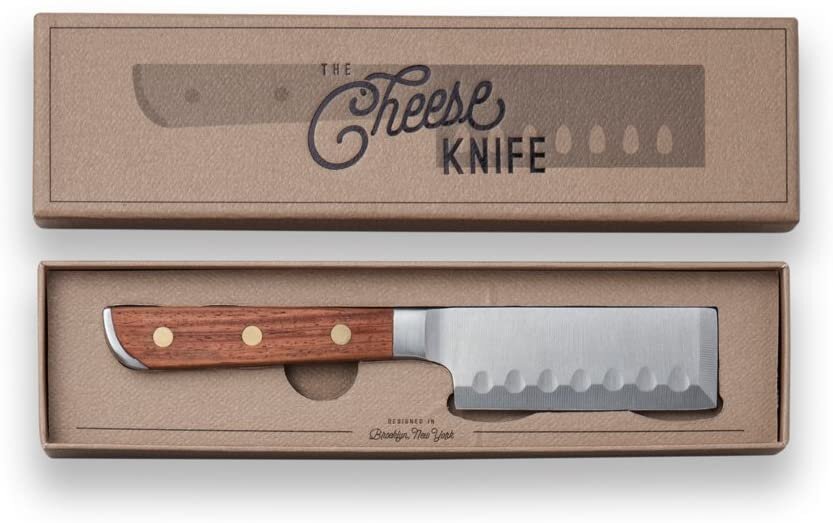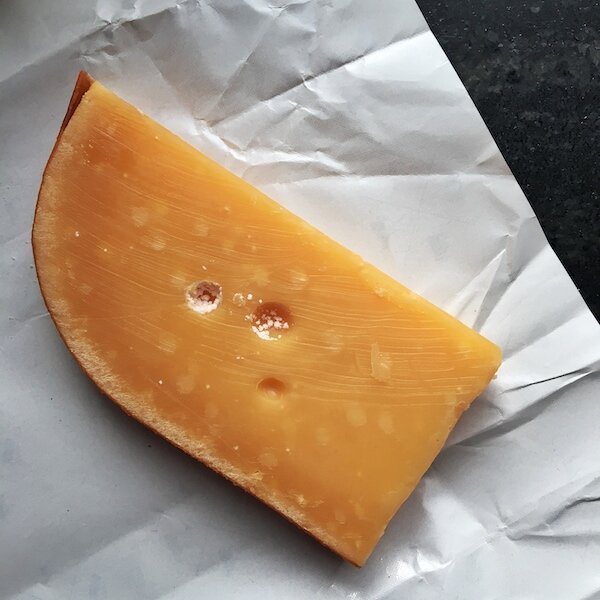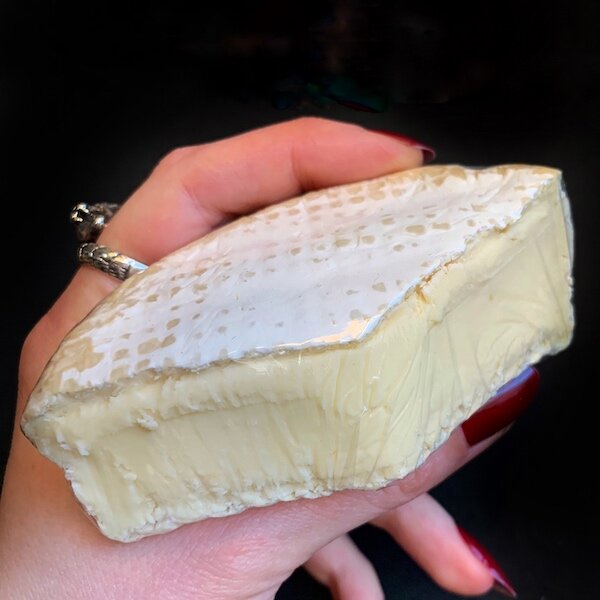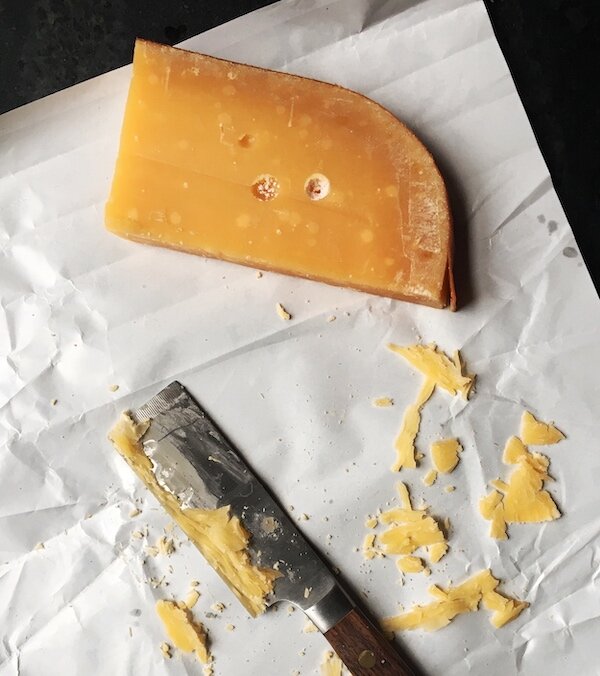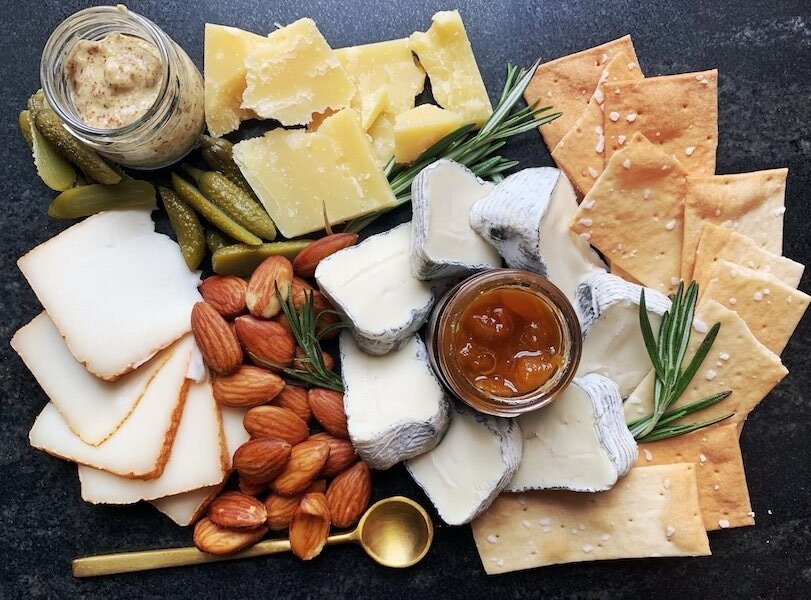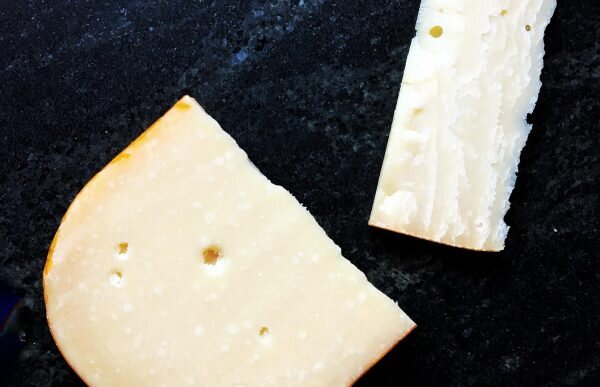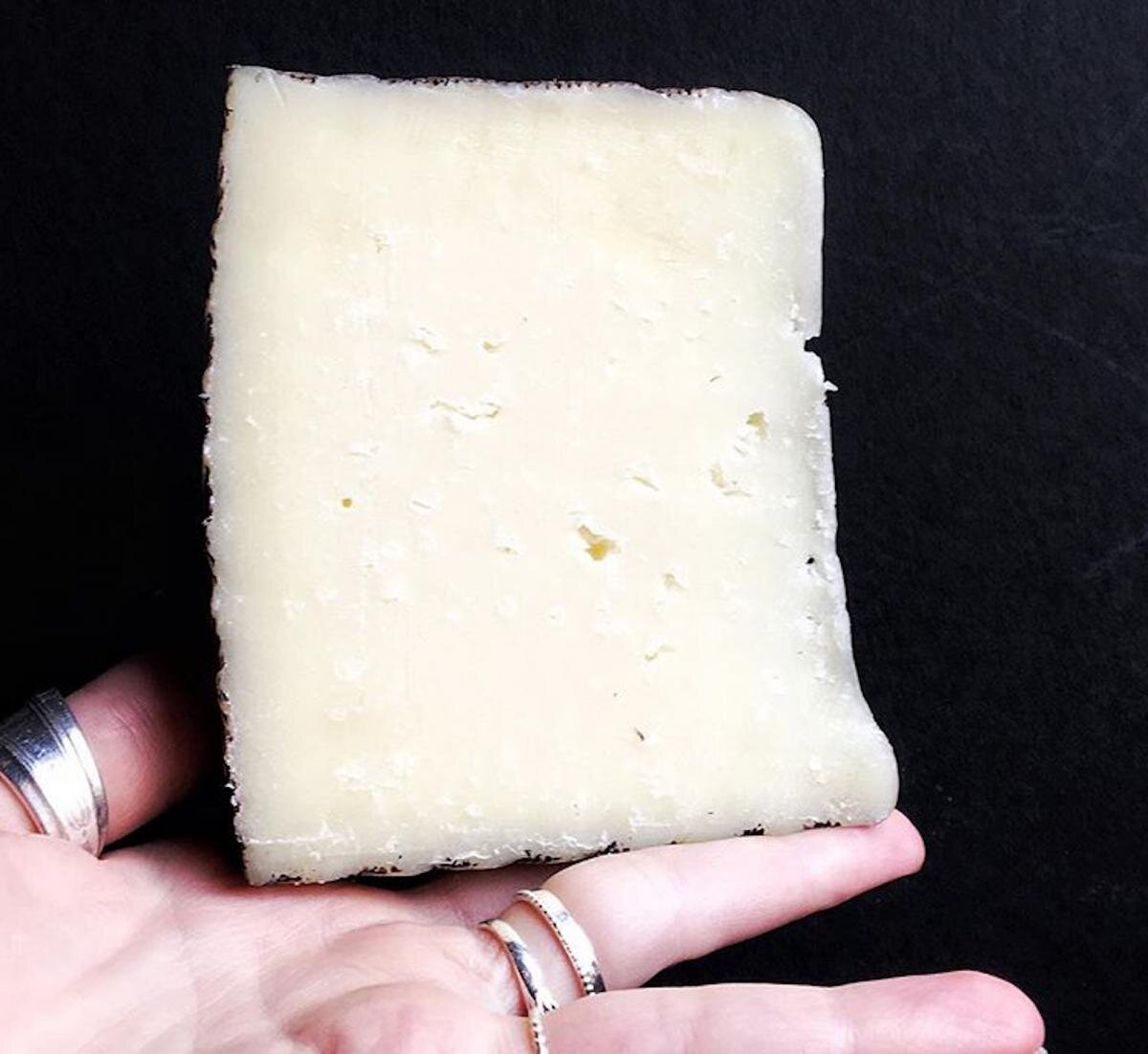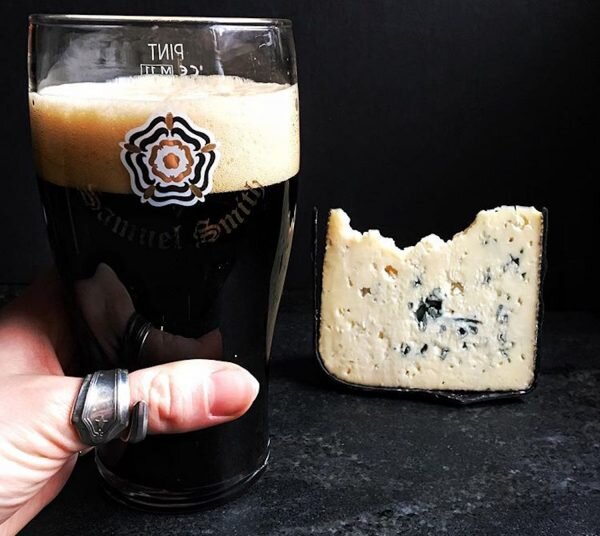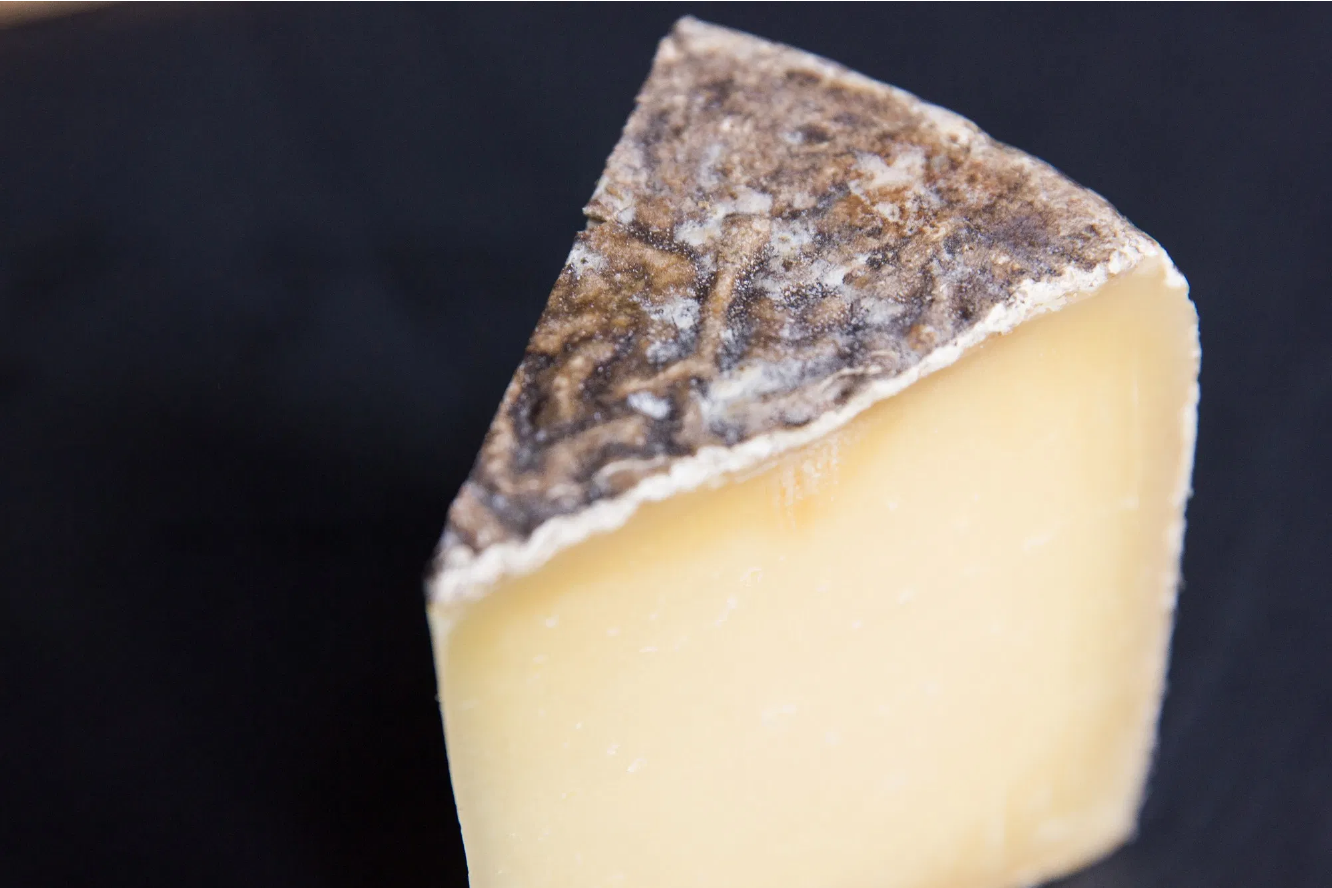Goat Cheese Pasta With Acorn Squash & Melted Leeks
This post is sponsored by Cypress Grove.
Working On That Winter Pasta Bod
I’ve found my new favorite pasta sauce. It’s easy to make and rich with creamy goat cheese,
and sings with all the flavors of fall. It looks a little like an alfredo but tastes way more interesting
because I’ve used some seriously clutch chèvre: PsycheDillic® from Cypress Grove in California.
Its bright dill flavors play off of roasted acorn squash, buttery leeks, and a squirt of lemon juice.
It’s. So. Good.
Honestly, I am not that into flavored cheeses. They’re often so overpowering you can’t taste the natural cheese flavor. And I’m obviously all about that natural cheese flavor.
But Cypress Grove’s PsycheDillic® has the perfect amount of aromatic and hand-harvested dill pollen and dill weed. The flavor is deep and seductive, but not overwhelming. It makes me crave smoked fish and bagels. It’s damn dill-ightful, especially when melted into this sauce.
PsycheDillic Pasta with Acorn Squash and Melted Leeks
Serves 2, generously
Ingredients:
For the sauce:
2 teaspoons butter
½ leek, white part only, cleaned and thinly sliced
1 tablespoon olive oil
2 garlic cloves, minced
2 tablespoons white wine
½ cup chicken broth
For the pasta:
1 lb. acorn squash, peeled and cut into 2″ cubes
2 teaspoons olive oil
6 oz rigatoni or fusilli pasta
extra PsycheDillic®, for garnish
lemon juice, to serve
salt and pepper
Equipment:
baking sheet, lined with foil or a silpat
saucepan
4-6 qt pot
Preheat oven to 400° F.
Toss squash with 2 teaspoons olive oil and a pinch of salt. Lay out on the baking sheet.
Roast until soft and browned, about 25 – 30 minutes. Stir halfway through to keep from burning.
Heat the butter in the saucepan over medium-low. Add leeks with a pinch of salt and sauté until golden and fragrant, about 5 minutes.
Pour leeks over acorn squash and toss.
Add 1 tablespoon olive oil to sauce pan. Add garlic and a little salt. Cook until fragrant and golden, about 2 minutes.
Whisk in the wine and broth. Bring to a simmer and reduce by half, about 10-15 minutes.
Crumble in most of the PsycheDillic®, reserving some for garnish. Whisk until thoroughly combined, and remove from heat.
Fill the 4-6 qt pot with salted water and bring to a boil. Cook pasta, according to instructions on package.
Drain pasta, and toss with PsycheDillic® sauce.
Distribute sauced pasta onto plates and top with squash and leeks.
Season with black pepper, a squirt of lemon juice, and extra crumbles of cheese. Enjoy!
Special thanks to Cypress Grove for sponsoring this post and the Cheese Sex Death mission!
Cheesus bless!
The Best Rosé & Cheese Pairings
Rosé and cheese make a pretty easy pair, especially compared to other wine pairings. They’re bright enough to cut through even the richest cheeses and the tannins are so gentle they won’t dull your palate. When you’re looking for some perfect wine and cheese pairings, get yourself a bottle of rosé and a couple of the cheeses below.
Rosé & Cheese All Day
Cheese is the perfect rosé wingman, and not just because the two are orgasmically delicious together. All that fat and protein slow the absorption of alcohol into your bloodstream, so you can drink more wine. That tart rosé also cleanses your palate, so you can eat more cheese. That means you can literally rosé all day.
Perfect cheese and wine pairings are finicky, but rosé goes with almost any cheese. Just avoid anything too strong or funky, which can overpower the delicate wine. Here are some of my favorite cheeses to pair with rosé.
How to Buy The Right Rosé Wine:
Look for rosés that are dry, tart, and/or bubbly, because those are the easiest to pair with cheese, versus sweeter varieties. My favs come from Southern France, so if you see either “Languedoc” or “Provence” on the label, just buy it. It’s probably delicious. They’re also inexpensive, and I strongly believe that you never need to spend more than $15 on a good rosé.
HERE ARE THE BEST CHEESES TO PAIR WITH ROSÉ:
Fresh Cheese, Like Burrata
Sweet, milky burrata loves nuzzling up to the fruity strawberry notes in rosé. The wine’s acidity cuts right through that dreamy, creamy center, prepping your palate for another bite.
Salty Fresh Cheeses, Like Feta Or Halloumi
Tangy cheeses and bright wines will keep your mouth watering for more. I highly recommend making yourself some marinated feta and warming up a little ciabatta to dip into all that cheesy olive oil.
Aged Chèvre, Like Humbolt Fog
Dense and cakey chèvres like Humboldt Fog crave something with a little brightness. I love how her bright, clean flavor teases out the wine’s mineral nuances. It’s a clean and elegant pairing, perfect for taking home to mom.
Alpine Cheese, Like Summer-Milk Comté
Definitely look for a raw milk Alpine-style, especially one made with milk from cows that feasted on summer herbs and flowers. Pair with a fruity rosé, which flirts with the gentle floral notes creating a seasonal bouquet on the palate.
Goat Gouda, Like Black Betty
Goat’s milk makes a great gouda because the milk’s natural sweetness intensifies with age. Paired with rosé, it tastes like strawberries and cream. I also love how the rosy hue by the rind matches the wine.
Aged Sheep’s Milk, Like Ossau-Iraty
All aged sheep’s milk cheeses are naturally buttery with lots of herbaceous flavors that blossom next to mineral-driven rosés. Pair these two with a plate of prosciutto, olives, and hot, crusty baguette.
Creamy Blues, Like Cambozola
You gotta be careful with blue cheese, since they can easily overpower delicate rosé wine. Look for something mild and creamy, like Cambozola. Add a few dried figs and indulge on a patio.
Parmesan-Crusted Brussels Sprouts
These crunchy, savory lil’ angels are not only extremely delicious, but they’re also super simple to make and only require four ingredients. Get ready to fall in love with parmesan-crusted Brussels sprouts!
These Parmesan-Crusted Brussels Are Packing Some Crunch
Crunchy, salty, and very addicting: these parmesan-crusted Brussels sprouts are about to become your new all-time favorite snack or side. They’re as delectable as potato chips, but they’re green so they’re basically salad. This Brussels sprout recipe is also really easy to make and only take about 10 minutes of real effort. For the sexiest flav, make sure to use a good parmesan, preferably real Parmigiano Reggiano from Italy.
Roasted Tart Cherries
These roasted tart cherries are plump, juicy, and begging to pleasure you. Serve over ice cream, or check out my tips on the best cheeses to pair with cherries.
Roasted Tart Cherries
Some cherries are so tart, it hurts to eat them. While I like a little masochism here and there, their intensity can overwhelm the delicate flavors in artisan cheese. Gently roasting tart cherries teases out their sweetness and softens their texture, transforming those puckery devils into plump and juicy cherries that are perfect for cheese platters. They’re also extremely easy to make, and pair well with a lot of cheeses.
BEST CHEESES TO PAIR WITH CHERRIES:
Fresh Cheeses, like Ricotta and Chévre. They’re also striking and luscious atop this Mascarpone Chèvre Tart
Triple Cream Brie, like Mt Tam or Saint André. They’re the cheese equivalent to unsweetened frosting, so they do well with any berry.
Wash Rind Cheeses, like Red Hawk or Grayson. Juicy fruits play off the custard notes in beefy stinkers. Washed rinds that have a soft, buttery texture tend to work best.
Goat Goudas, like Midnight Moon. They’re much sweeter than cow’s milk gouda, with fruity notes that complement the cherries.
Creamy Blue Cheese, like Cambozola. The sweet cherries contrast against the salty notes in luscious blues. Add some dark chocolate to take this one to the next level.
HOW TO ROAST CHERRIES
Use this recipe to sweeten sour cherries, or bring a little extra something to bings or rainiers.
Roasted Tart Cherries
Gently roasting tart cherries teases out their sweetness and softens their texture. Pair with goat gouda or brie.
Servings: 4 people
Equipment
Baking Sheet
Tin foil
Ingredients
1 cup sour cherries, pitted
2 tbsp honey
zest of 1 lemon
1 pinch salt
Instructions
1. Preheat oven to 400°F. Cover the baking sheet with tinfoil.
2. Toss cherries in honey, juice, and zest. Season with a pinch of salt.
3. Spread the cherries evenly onto the baking sheet.
4. Roast for 15 minutes, stirring halfway through. Let cool.
5. Pour cherries and their juices into a jar and cover. Store in the refrigerator. They’ll stay good for about a week.
MORE IDEAS ON HOW TO EAT ROASTED TART CHERRIES:
PUT THEM ON A SUMMER CHEESE PLATE
POUR THEM OVER THIS GOAT CHEESECAKE
EAT THEM WITH THIS BAKED BRIE
The 9 Best Melting Cheeses
Basically the Porn Stars of Cheese
Every cheese is beautiful and talented in their own way, but some are just better at melting than others. How well a cheese can melt depends on its moisture content, age, and acidity. Old, grate-ables like Parmigiano aren’t flexible enough to melt. Tangy freshies like feta and goat cheese soften, but won’t get gooey. And squishies like brie and Taleggio liquefy into an oozing puddle when heated. So, how do you know which cheeses will melt into stretchy seduction?
The best melting cheeses are young, semi-firm fatties like the sexy porn stars below. For best results, always use these queens at room temperature and grate them fresh.
1. Low-Moisture Mozzarella
All hail the pizza queen! This mild mistress is made by heating and hand-stretching the curd, so she always makes the best cheese pull. Low-moisture types have a lot less moisture than fresh mozz, which turns into a soggy mess when heated.
2.Provolone
This Italian stallion is stretched just like mozzarella, but she’s packing a funkier flavor. Get yourself some hot ciabatta and panini her up with prosciutto, roasted tomatoes, and a drizzle of balsamic vinegar.
3.Gruyère
You’ll find this Swiss seductress draped over French onion soup, whisked into fondue, and stuffed inside Croque Madames. I especially love her on this French onion soup grilled cheese.
4.Fontina
Funky Fontina is an Alpine-style cheese just like Gruyère, but made in Italy. She’s sporting a silky, supple bod and a slightly beefy flavor that begs for a chargrilled burger and some roasted red peppers.
5.Young AF Cheddar
The older a cheddar gets, the more acidic, dry, and crumbly it becomes. That means it’s more likely to separate when heated. Look for blocks that are a year old or younger, and definitely try it melted over tater thots.
6.Raclette
This slightly stanky Frenchie is made for the melt! Traditionally heated under a grilled and scraped onto potatoes, Raclette will add a little funky kink to grilled cheese, mac, or even a hot and willing sausage.
7.Fresh Curds
Basically cheddar in its infancy, cheese curds are young, moist, and serve up a satisfyingly chewy stretch. You’ll want to use curds that have been around for a couple days, which stretch better than the squeaky fresh ones. Chop them up and pair with bacon on a grilled cheese or bake them into a breakfast strata.
8.Queso Oaxaca
This mild, milky Mexican queen melts like the lovechild between Monterey Jack and semi-firm mozzarella. Stuff her into Enchiladas, slide her into a quesadilla, bake her into fundido—she can do it all.
9.Young Gouda
Save the crunchy aged goudas for your platters. Creamy, tangy, and slightly sweet, young gouda makes a sexy little canvas for all kinds of flavor combinations. Slice thin, melt onto a hot slice of wheat toast, then top with sliced green apple and honey.
A Guide to Cheese Knives
There are a lot of different kinds of cheese knives out there, each with their own purpose and use. It’s equally as important to slice brie with a soft cheese knife as it is to crumble a gouda with a tool that’s meant for a harder texture. Don’t worry cheese sluts, I’m here to help with this guide to cheese knives.
The Essential Guide to Cheese Knives
The way you slice a cheese affects the flavor and texture, so it’s important to use the correct cheese knives to get the perfect cut. But how do you choose the right cheese knife? If you use a thick chef’s knife on a delicate ripe wedge of brie, you might smush its pretty shape. If you use a soft cheese knife on something hard like Parmigiano, you’re going to end up with some really weird looking cuts.
You Don’t Need All of These Knives, But You Do Need Two
The only essentials are a soft cheese knife with a thin blade and a sharp chef’s knife for firmer cheeses. The others are fun and will make you feel badass, but they’re not necessary.
How To Choose The Right Cheese Knife
The texture of the cheese that you’re eating will determine what knife to use. There are a lot of different tools out there: some are for soft cheese, some are for semi-firm bad boys, and some are for those hard, grate-able girls. Below I’ve outlined all of the different knives on the market, each with a link to the Amazon page for some of my favorite knives. If you happen to buy one, a small commission goes to the cheese church AKA into my bank account.
FOR SOFT CHEESE:
For Semi-Firm and Hard Cheese:
Fork-Tipped Knife
He’s a knife and a fork! What a stud. Use this cutie to slice semi-firm babies like young gouda and Havarti, then use that fork-tip to stab a chunk and pick it straight up to your face.
The Cheese Plane
This fancy-looking number is for all those aged cheeses with deep, complex flavors that need a little extra surface area to properly pleasure your palate. Use it to shave razor-thin slices off of Alpine-style cheeses and Gjetost.
The Spear Knife
Big boy blades like this spear knife are for chipping snackable chunks off of crumbly blues or crunchy baddies like aged gouda and Parmigiano.
All-Purpose Knife
If you’re going on a picnic or BYO-Cheesing and you only want to bring one knife, use a foldable guy with a pointy tip and thin blade. It will crumble the crunchies, slice the softies, and spread the freshies. Just be sure to wipe off the blade between cheeses lest you cross-contaminate those precious flavors.
Now let’s put that cheese knife to work!
How to Store Cheese
Understanding how to store cheese is essential knowledge for all cheese sluts. Those sultry little wedges in your fridge need ample oxygen and humidity, which is why you should never store your cheese in plastic wrap. Here’s a guide on how to store your cheese, including a breakdown of the shelf life of cheese.
And Keep it Fresh AF
Understanding how to store cheese is essential knowledge for all cheese sluts. Those sultry little wedges in your fridge need ample oxygen and humidity, which is why you should never store your cheese in plastic wrap. Proper cheese care is actually very easy. Here’s a guide on how to store your cheese, including a breakdown of the shelf life of cheese.
How to Store Cheese Like a Good Cheese Slut
Cheese is alive and breathing, which means it needs oxygen and humidity to stay fresh and tasty. Now, I know it’s convenient to just keep your cheese in the plastic wrap it came in, but it’s just as easy to take care of it properly. Proper cheese storage is very simple and only takes a few minutes of actual effort. Your cheese will reward you with the sexiest flavor experience possible.
3 REASONS WHY YOU SHOULD NEVER STORE YOUR CHEESE IN PLASTIC WRAP
1. IT SUFFOCATES THE CHEESE
Plastic wrap cuts off the air supply, essentially suffocating your specimen. A suffocated cheese will eventually die, leading to tragic off-flavors and textures that are weird in all the wrong ways.
2. IT TRAPS IN MOISTURE
Cheese needs the right amount of humidity. If there’s too much moisture trapped inside the wrapper, the rind will become slimy, moldy, and the wrong kind of smelly.
3. IT LETS IN LIGHT
Because it’s clear, plastic wrap lets in a lot of light, which can oxidize aged cheeses. This destroys their sexy complexities and leads to a nasty, crayon-like flavor.
How to Keep Your Cheese Fresh AF with Proper Storage
1. IF YOU’RE BUYING CHEESE THAT WAS STORED IN PLASTIC, CHECK THE DATE FIRST.
Of course, a lot of retailers wrap cheese in plastic, both for convenience and to make it easier for consumers to see the cheese they’re considering. While cheese needs oxygen to breathe, it’s very good at holding its breath for short periods of time. Check the date to make sure it’s only been in plastic for (ideally) a week or less. If there’s only a sell-by date, use your best judgment by checking fordiscolored spots on the paste or cracks in the rind.
2. SLIP OFF THAT PLASTIC WRAP AS SOON AS YOU GET HOME
When you get home for the cheese store, slide off that plastic wrap and let your cheese breathe for a few minutes. If the cheese is firm and tastes a little like a refrigerator, take a non-serrated chef’s knife and slightly scrape off that little glossy layer on the paste.
3. WRAP YOUR CHEESE IN SPECIALTY CHEESE PAPER, OR ELSE PARCHMENT PAPER AND A ZIPLOC.
Specialty cheese paper provides airflow and humidity, which keeps your cheese healthy and happy. When you’re tucking it in for storage, make sure not to leave any parts exposed, because the fridge will dry them out and make them crusty. I prefer Formaticum’s cheese paper (see disclaimer at the bottom). Alternatively, wrap the cheese in parchment or butcher paper. Then, loosely wrap it in a Ziploc bag. Before closing the zipper, make sure there’s still some air in the bag so your cheese has plenty of oxygen and humidity.
4. IF YOU FIND MOLD ON YOUR CHEESE, JUST SCRAPE IT OFF.
Remember when I said that cheese was alive? That’s because it’s fermented, so there are all kinds of mold and bacteria crawling all over it. Sometimes the wrong ones hop onto the wrong places, and you’ll start to see white fuzzies on the inside of your cheese. It’s not going to hurt you, so before you toss that wedge, just scrape o that mold and even change the wrapper if you want to be extra careful. The only exception to this rule is fresh cheese: if those get moldy, it’s best to throw them away.
The Shelf Life Of Cheese
Now that you know how to store your cheese, let’s talk about how long it will last. This all depends on the type of cheese as well as the size of the individual piece. The smaller the piece, the faster it will go bad. Keep in mind that a wheel of cheese stops ripening and begins to deteriorate as soon as it’s cut, so it’s best to buy only as much as you need for the week, eat it fast, and then buy more.
Here’s how long each type of cheese typically lasts.
Fresh Cheeses, like ricotta: 1-3 days
Because they’re so fresh, these cheeses are best consumed as soon as possible after opening the package, otherwise they’ll get sour. The exception here is feta stored in a brine, which stays preserved for several months thanks to that salty bath.
Bloomy-Rind Cheeses, like brie: 5-10 days
The ripeness of these cheeses determines their shelf life. Intact wheels of brie will continue to ripen until you cut the rind, a er which it starts to deteriorate. If it’s a young wheel, you might have an extra week. If it’s close to the expiration date, eat it up.
Washed-Rind Cheeses, like Taleggio: 1-2 weeks
The shelf life of stinky washies really depends on how much moisture is in the cheese. Squishy boys, like Époisse, have a lot of moisture, so they’ll go bad more quickly. Firm washies have less, so they’ll last longer.
Aged Cheeses, like Gruyère: 3-6 weeks
The harder the cheese, the more durable it is. I’ve even kept big wedges of Parmigiano in my fridge for a couple of months, and they’ve survived virtually unharmed. Still, their flavors will dull with time, so the sooner you eat them the better. Just check for mold every week or so.
Blue Cheeses, like Stilton: 1-2 weeks
Like the previously mentioned varieties, the shelf life of blue cheese depends on its texture. So ones will last about a week, while firmer ones will keep longer.
DISCLAIMER:
This post was not sponsored by any brand or company, and all opinions expressed herein are my own. I do, however, work as a digital marketing consultant and content creator for Formaticum. I truly believe in their products and highly recommend that everyone try them for all their cheese storage needs. If you click on any of the above links and make a purchase of Formaticum on Amazon, I will get a commission on it. Consider it a donation to the Cheese Church!
How to Cut Cheese the Right Way
Learning how to cut cheese is one of the most important skills a cheese slut can master. Whether you’re breaking down a wheel of brie or slicing up a wedge of gouda, the way you cut it affects the taste and texture of the cheese. So, how do you cut cheese the right way?
Cut the Cheese
How you slice a wedge of cheese isn’t just about aesthetics: it affects the way a cheese tastes and feels in your mouth. Every cheese has a preference for how it wants to be cut, and you can always tell based on its shape. Here’s a helpful little guide on how to cut cheese the right way. If you’re building a platter, you don’t need to cut up every cheese completely. I actually recommend against it, because if not all the cheese is consumed, then the slices will deteriorate fast versus an intact wedge that will keep longer. However, making the first incision will help guide your guests and prevent mangled cheese.
How to Cut Cheese, According to Its Shape
Round
You’re aiming for a perfect rind-to-paste ratio, so try to slice it into wedges just like you would a pie or cake. Start by slicing in half, then turn and cut it in half again so you have quarters. Continue bisecting into smaller pieces, depending on the wheel’s overall size. Each piece should be half an ounce.
Examples: Bonne Bouche from Vermont Creamery, Camembert from France, Mt Tam from Cowgirl Creamery
Square
It’s the same philosophy as the round wheel: you want a little rind and a little paste. Slice into triangles just like you would a grilled cheese. Cut it in half diagonally, corner to corner. Then, cut in half from the opposite corners so that it’s in quarters. Bisect perpendicularly, from both top-to-bottom and side-to-side.
Examples: Taleggio from Italy, Pont-l’Évêque from France, or block cheddar like Red Rock
Logs
These are usually soft goats. Slice into coins, about 1/4“ thick. If it has a large diameter, like bucheron, you can then cut it like a pie, the same way you would cut a round wheel.
Examples: Saint-Maure, Cana de Cabra, fresh chévre
Pyramid
You’re going to take the same approach as you would a square for this small category of bloomy-rinded cheeses. Keeping the bottom flat, cut in half from corner to corner. Then, cut in half perpendicularly on both sides.
Examples include Capriole Pipers Pyramid, Baetje Farms Bloomsdale, and Valençay
Spruce-Wrapped Rounds
Keep these ladies inside their bark, or they’ll ooze all over the place. Use a paring knife to carefully slice all the way around the top rind, just inside the bark. Slowly peel back and remove the top rind, then stick a spoon in her creamy center. You can also just take o half the top rind, which makes for a sexy, scantily clad presentation.
Examples: Vacherin Mont d’Or from France, Harbison from Jasper Hill Farm, or Rush Creek Reserve from Uplands Cheese
Rectangle
These guys come in huge wheels and are very aged, so they’re going to have a lot of deep flavors. The key to accessing those flavors is surface area, meaning you want thin slices rather than cubes. Use a very sharp knife and slice them 1/8” thick lengthwise, from the top rind to the bottom rind.
Examples: Gruyère, Emmentaler, and Comté
Triangular Wedge
You also want a lot of surface area here, so keep the slices thin. Cut off the top and bottom rind, then slice lengthwise into thin triangles. Leave the back rind on to use as a handle, like pizza crust.
Examples: Manchego, Pleasant Ridge Reserve, and Tomme
Crumbly Cheeses
No matter how hard you try, you’ll never get a clean cut from a super fudgy blue or a crunchy aged cheese. They just want to crumble, so let them. Set out a large “showpiece” and crumble a portion into snackable chunks with the tip of a knife.
Examples: Maytag Blue, Parmigiano, Aged Gouda
How to Eat Cheese When You’re Lactose Intolerant
Yes, you can eat cheese without destroying your insides.
ATTENTION ALL LACTOSE INTOLERANT PEOPLE: YOU CAN EAT CHEESE!
A lot of people who are lactose intolerant think that they cannot eat cheese, but that is 𝙛𝙖𝙠𝙚 𝙣𝙚𝙬𝙨. Even if ice cream destroys your insides, you can still comfortably indulge in cheese on the regs. Why? Because cheesemaking converts lactose (milk sugar) into lactic acid. Any cheese aged 2 mo. or more is virtually lactose-free.
Let me show you the light, dear cheese slut. I’m here to answer all of your questions about eating cheese while lactose intolerant.
So, WTF is lactose?
Lactose is milk sugar.
…and WTF is lactose intolerance?
Lactose intolerance is when you have problems digesting the milk sugar in dairy. The lactose ferments in the small intestine, leading to uncomfortable feelings of indigestion, bloating, and worse.
Ok, so what foods have lactose?
Non-fermented, fresh dairy products, like milk and ice cream.
…and what foods don’t have lactose?
Fermented dairy products, like yogurt, kefir, and aged cheese. Butter also has very low levels of lactose, thank Cheesus.
What’s up with this lactose intolerant cheese?
Well, technically cheese still has some lactose. There are just teeny tiny trace amounts leftover that your body probably won’t notice.
But why are they low in lactose?
There are actually two reasons why cheese is safe for the lactose intolerant:
The process of cheesemaking converts lactose into lactic acid
Once a cheese is cultured, the curds (milk solids) are drained of their whey milk liquid). The whey is what contains the lactose. As the cheese ages, it leaks out even more whey.
So, can I eat ALL the cheese?
Tread lightly, my friend. Avoid processed cheeses, such as American and deli Swiss, which are blended with lactose-heavy whey to make them melt better. Also, be careful with fresh cheeses, like mozzarella and ricotta. They have more lactose than aged cheeses.
Then, what cheeses can I eat?
Start with a hard, aged cheese, such as Parmigiano Reggiano. These have virtually no lactose. Parmigiano is also made with raw milk, which has more probiotics that can improve digestion.
So, I can only eat hard cheese?
Nah, I’m just giving you a jumping off point. Start slow and steady with an ounce of hard cheese. If that goes through your body easily, try a younger cheese such as Wisconsin cheddar. If that works out, then try going even younger with a little bit of brie. See what you can handle and go from there.
But what if I’m still getting sick from this cheese?
Try an aged sheep or goat milk cheese like Spanish Manchego or Midnight Moon gouda from Cypress Grove.
And if I’m still getting sick?
Unfortunately, you might have a dairy or casein allergy and might need to avoid dairy altogether. Sorry boo.
Best Blue Cheese Pairings
5 ORGASMIC BLUE CHEESE PAIRINGS TO TRY ASAP
A LITTLE SOMETHING TO COZY UP WITH
Are y’all excited for autumn? I know I’m ready AF for some thick sweaters, extra whiskey, and Halloween. I’m also ready to shift my bedroom eyes from the refreshing cheeses of summer to those with a little more meat on the bones. When the weather cools, I wanna get kinky with some blue-veined beauties. Here are a few of my favorite blue cheese pairings for you to get cozy with this fall. I’ve got a suggestion for every type of blue, but they’re all interchangeable. So go ahead and fool around with them, then let me know which are your favorite combinations.
FOR EARTHY BLUES: DARK CHOCOLATE
Dark chocolate has the right sweet-to-bitter ratio to tease all the best earthy qualities out of a rustic, barnyard-y blue cheese. Mess around with truffles, drinking chocolate, or even melt it down and dip the cheese right in there. My favorite combination is Rogue Creamery’s Smokey Blue, a lightly smoked cheese with notes of bacon and sweet cream, paired with indulgence Chocolatiers porter bar infused with espresso and barley malt.
Try in with Rogue Creamery Smokey Blue, Jasper Hill Farm Bayley Hazen Blue, or Stichelton.
FOR BOLD BLUES: BUTTER
All the extra fat in butter mellows that kinky blue funk and helps the complexity spread across your tongue so you can taste more of it. Use a high-quality, tempered butter and either mash it right into the blue or generously layer it onto a baguette and top with thick slices of cheese.
Try it with Roquefort, Cabrales, or Muffato.
FOR SALTY BLUES: HONEY
This one’s a no-brainer: sweet honey is the perfect counterpart to salty blues. For best results, treat yourself to a really good honey, either a creamed and spreadable version or one that drizzles, and pair with crackers or baguette.
Try it with Gorgonzola Piccante, Stilton, or Valdeón.
FOR CREAMY BLUES: BEEF
Ever had Roquefort sauce on steak frites? If not, then brahhhh—what are you doing? Blue cheese has a natural meatiness that makes sweet love with some actual red meat. Use a creamy blue for easy melting and pop it on a burger or a roast beef sandwich. If you’re feeling extra naughty, finish it off with a little bacon-onion jam.
Try it with Cambozola, Chiriboga, or Cashel Blue.
FOR ANY BLUE: STOUT
From creamy and mild to biscuity and funky, a rich, chocolatey stout will seduce nearly any blue. The combination of deep malty flavors and blue funk is a no-fail match made in heaven that makes for a perfect dessert or even dinner. If you don’t drink, a cup of black coffee is equally delicious.
Try it with Point Reyes Bay Blue, Sequatchie Cove Creamery Bellamy Blue, or Maytag Blue.
Cheese for Cheap Asses
Why is cheese so expensive?
There are two kinds of cheeses in America: there are the inexpensive, industrially produced cheeses like the cheddar at the supermarket, and then there are the more expensive, artisan cheese at fancier cheese counters. For a long time the industrial stuff dominated our cheese scene, but recently we Americans have set their sights on the sexy artisan stuff. The people have spoken, and they want good cheese. There are cheeses out there that are both quality and affordable, and I’ve detailed those below for you, but first let’s discuss why the good stuff costs so much in the first place. It’s all about basic economics: artisan cheesemaking requires a lot more resources and it produces a lot less product. Here’s a breakdown of what you’re paying for when you buy the good shit:
1. YOU ARE PROMOTING ANIMAL WELFARE.
Good milk comes from happy animals, and that requires a lot of resources and small herds that produce small quantities of milk.
2. YOU ARE PAYING THE CHEESE PRODUCER THEMSELVES.
Making artisan cheese means long hours, back-breaking work, and lots of inconsistency. They have to account for bad weather, crops, and batches.
3. YOU’RE PAYING FOR PREMIUM TRANSPORTATION.
Artisan cheese is delicate and needs to be transported carefully. Smaller quantities of product also mean higher per-mile transportation costs.
4. AND YOU’RE SUPPORTING YOUR LOCAL CHEESE SHOP.
Unlike supermarkets, cheese shops cost a lot to operate, including massive overhead for labor, product, and rent. And yet they still need to make a profit, too.
So that’s why good cheese can be so expensive. And even though we all know that the good shit is well worth the price, sometimes we just can’t afford the splurge. Don’t worry—there are still plenty of sexy, affordable to pleasure yourself with even if it’s rent week. Here are some of the inexpensive cheeses for us cheap asses.
DOUBLE & TRIPLE CREAM BRIES
These guys are total crowd pleasers, and there are a lot of French brands making affordable wheels. Look for Fromage d’Affinois or get yourself a piece of Delice de Bourgogne from Trader Joe’s. Serve them with apple slices and honey.
BLOCK CHEDDAR
When it comes to cheddar, look for one that promotes its state and farm: the more a company reveals about itself, the better. A couple of my favorites include Face Rock Creamery from Oregon; Hook’s and Widmer’s from Wisconsin; and Grafton, Shelburne Farms, and Plymouth Artisan Cheese from Vermont. Serve with pickles and Ritz.
THE DOPS
Any cheese that says “DOP” on the label is guaranteed to be DOPe. They’re all government protected cheeses from Europe, and can mostly survive mass production without losing quality. Look for Gruyère, Comté, Manchego, and Pecorino. You can even find some good ones at Costco and Trader Joe’s. Note that AOP and PDO mean the same thing.
THE FRESHIES
Fresh cheeses are generally cheaper than those that spend time in the aging room. Because they’re more affordable, you can treat yourself to something small-batch and local without breaking the bank. Or just get some feta from Trader Joe’s and marinate it.
CHEESE FROM SARTORI AND BEEHIVE
Beehive Cheese and Sartori are two creameries that make affordable and consistently delicious wedges. Some are even rubbed down in kinky flavors. Look for Sartori’s Black Pepper BellaVitano or Beehive’s Barely Buzzed, coated in espresso and lavender. If you want something straight up naked, try my gateway cheese, SarVecchio.
CHEESE ORPHANS
At almost every cheese counter, there is a wonderful little bin of what I call “cheese orphans,” or odds and ends that are looking for a home. You can usually find a crazy variety of cheeses for just a couple dollars. Just make sure they look lively and were cut within the past week.
How to Taste Cheese
Look, Smell, Feel, Taste, Pair
I believe that eating cheese is a form of meditation. It’s an opportunity to let go of everything and fully give yourself to cheese. It’s a complete sensory escape. You don’t have to be a connoisseur to appreciate cheese. Here’s a guide on how to taste cheese like a pro. For best results, start with room-temperature cheese. Refrigeration dulls the flavor.
HOW TO TASTE CHEESE
1. LOOK
Give her the elevator eyes, appreciating the beauty of this masterpiece. Observe the color of her paste and rind. These visual cues will hint at how she’ll taste. For example, if the rind is orange or red, expect some funk.
2. SMELL
Take a good sniff: What comes to mind? Flowers, vegetables, toasted nuts, toffee, lemons? Take note of what her smell reminds you of; this will open your taste buds to nuanced flavors. Describing the aroma will also build a vocabulary so that when you do taste it, you can talk about it.
3. FEEL
Go ahead and feel her up. Give her a gently squeeze. Is she crumbly, springy, elastic? Will she spread onto bread? Observing the texture in your hands is like a preview of how she’ll feel in your mouth.
4. TASTE
Now for the best part. Take a bite and press the cheese against the roof of your mouth, letting all your senses blossom together. Concentrate on how it feels in your mouth and what flavors emerge. Scroll to the bottom of this post for a tasting glossary.
5. PAIR
Now that you’ve fully experienced your cheese by herself, try adding an accompaniment or beverage to pair. Take another bite and follow with a drink. Spread her on a cracker or dollop with some jam – anything you want to take this relationship to the next level.
TASTING GLOSSARY
Spicy: Nutmeg, black pepper, vanilla, pungent
Lactic: Fresh milk, cream, yogurt, and fresh butter
Fruity: Apricots, lemons, apples, honey, and flowers
Roasted: Toasted bread, coffee, roast nuts, chocolate, tobacco
Vegetal: Grass, onions, potatoes, soil, and cabbage
Animal: Beef broth, custard, wool, barny, gamey
Where to Buy Cheese Online
It all begins with an idea.
A directory of American cheese shops with webstores. Click here to find a cheese shop near you.
Eastern US
BKLYN Larder (NY)
Curds and Co (MA) https://curdsandco.com/
Cheese Shop of Salem (MA)
Chantal's Cheese (PA)
Dedalus (VT)
DiBruno Brothers (PA)
Fairfield Cheese Co (CT)
Fromaggio Kitchen (MA)
Jasper Hill Farm (VT)
Mad River Taste (VT)
Murray's Cheese (NY)
Olsson’s Fine Foods (NJ)
Orrman 's Cheese (NC)
Parish Hill Creamery (VT)
PennMac (PA)
Saxelby's Cheese (NY)
Scott & Joe (NY)
Western US
DeLaurenti (WA)
Face Rock Creamery (OR)
Caputo's (UT)
Rumiano’s (CA)
Middle States
Cheese House (OH)
Door County Cheese (WI)
Fromagination (WI)
Goose the Market (IN)
Landmark Creamery (WI)
MouCo Cheese Company (CO)
Monger's Provisions (MI)
Prairie Fruits Farm (IL)
Red Head Creamery (MN)
The Rhined (OH)
Zingerman's (MI)
Southern States & Territories
Antonell's (TX)
St James Cheese Shop (LA)
Surfing Goat Dairy (HI)
Sweet Grass Dairy (GA)
